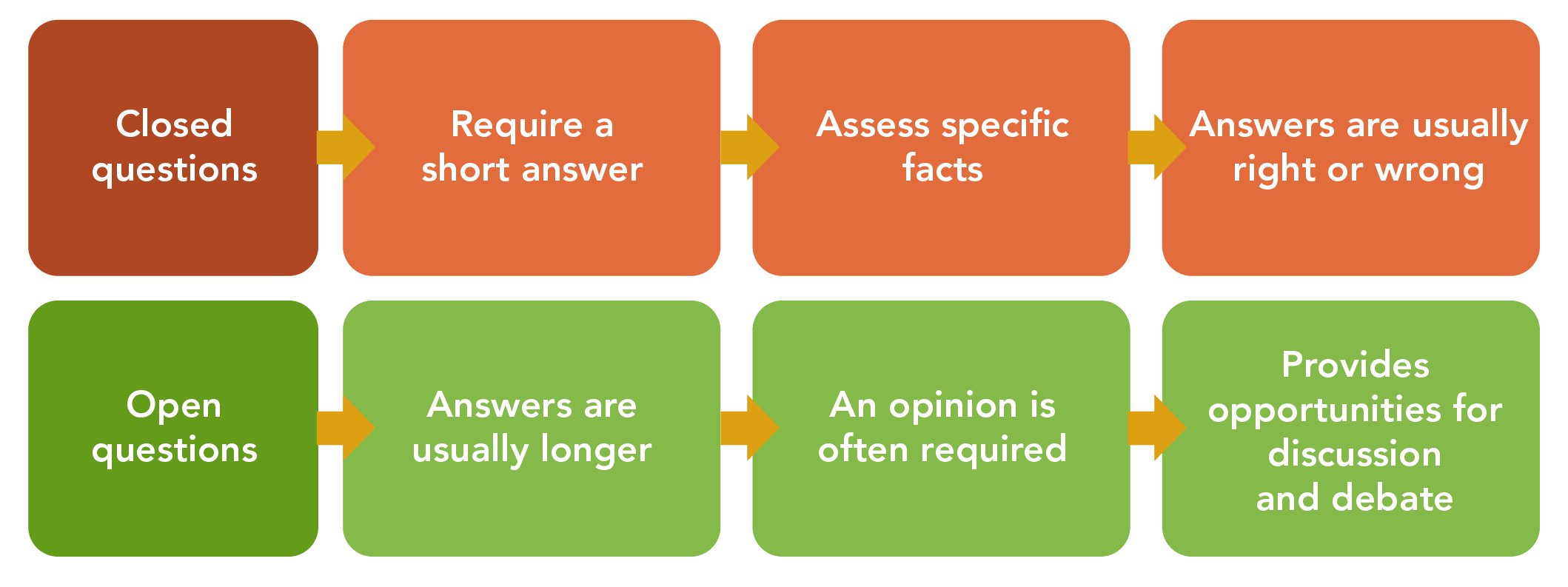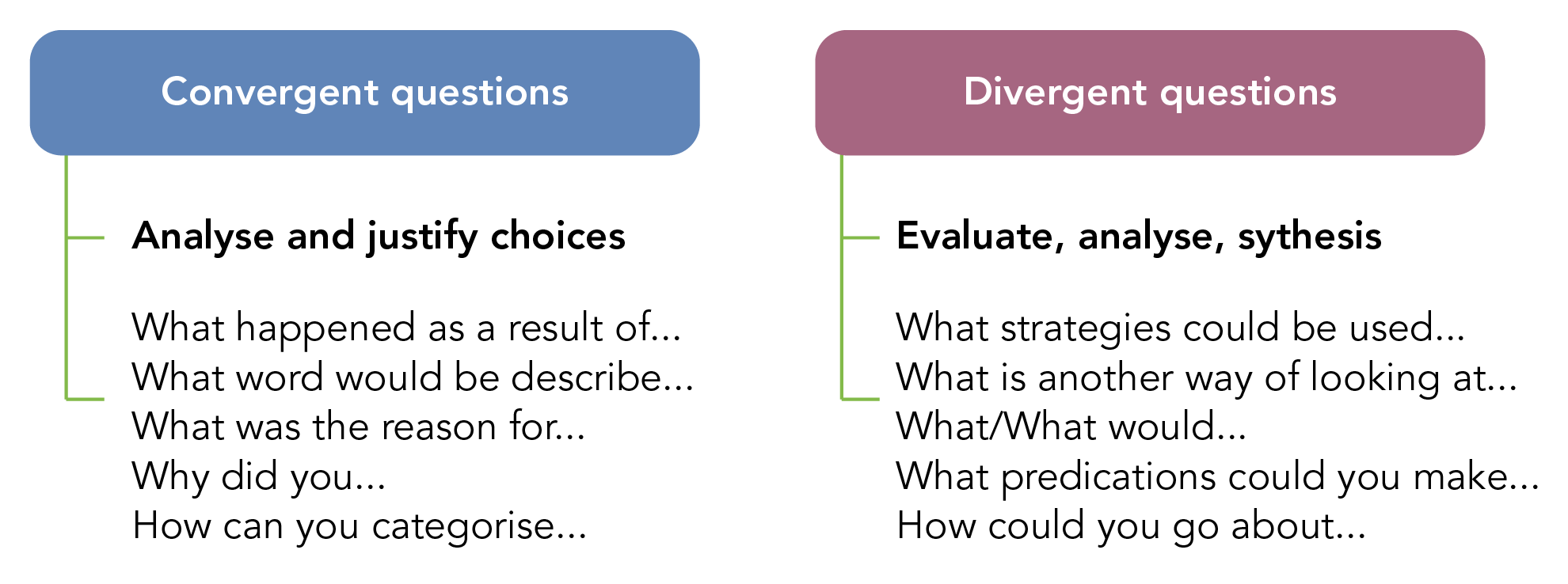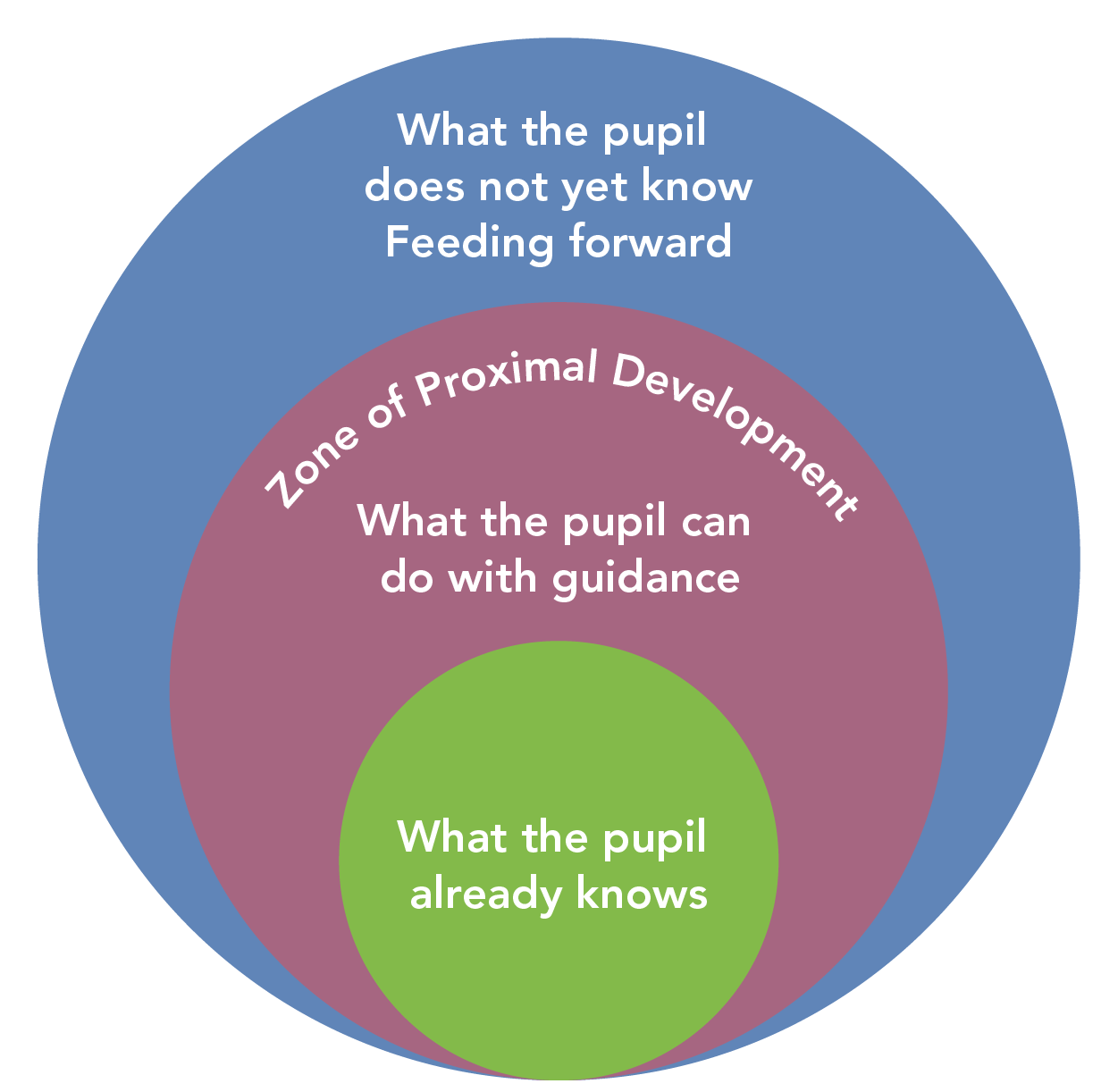Planning assessment using oral questions
Questioning, dialogic discourse and oracy are recognised as important aspects of teaching and learning but we must not forget that they are also important features of assessment. Questioning is routinely used as a formative assessment strategy. The teacher asks questions to establish whether pupils understand the content being shared. Misconceptions can be identified, and progress can be measured. The teacher can then make an appropriate learning decision and guide pupils to achieve the objectives.
Within a cognitively challenging learning environment the planning for teaching and assessment will include questions designed to not only to achieve these purposes but also to deepen, challenge and inspire learning. To develop assessment practices which support cognitively challenging learning the teacher must consider the nature of the questions being asked and their position within the lesson.
Teachers often use closed questions which require a specific response enables the teacher to assess whether specific facts are remembered. Closed questioning may include:
- quick fire questions (hands up response)
- peppered questions (quick retrieval around the class no hands up)
- call and response (ritual and repetition, response in unison)
- whole class response (possibly using white boards)
It is important for all pupils and particularly more able pupils to have a wide repertoire of knowledge and skills. By using these ongoing low stakes assessments pupils develop their knowledge recall and memory. The disadvantage of closed questions when working with more able pupils is that they often distract from the learning and take place when deeper learning is possible. The teacher must therefore plan carefully for these and have a good understanding of the needs of the class so that the questions are perceived positively within the learning and lead to benefits for the pupils.
By contrast open questions provide opportunities for healthy discussions and debate. Open-ended questions add interest to the lesson; challenging the pupils and enhancing thinking. The teacher can use these to check understanding, gain a fresh perspective on pupils’ learning and promote cognition.

If pupils need to bring together ideas to solve problems then convergent questioning may be used. At the start of a lesson or topic the convergent question might be used to assess existing knowledge and understanding. To encourage convergent thinking the teacher may ask pupils to analyse different types of solution and justify their choice of the most appropriate solution. By contrast a teacher wishing to assess higher order cognitive learning such as evaluation, analysis or synthesis may use divergent questions.
One type of divergent question which is often used to both teach and assess learning is the “BIG QUESTION”. Using this, the teacher opens the learning up to include greater breadth and depth. A Big Question has the potential to promote independent learning through research and shared knowledge. A teacher may use this type of question to enable pupils to move beyond the planned content and introduce their own experience and interests. Alternatively, the question may be devised to provide cognitive challenge and to help pupils to organise the knowledge they already possess. Although this style of questioning is often viewed as a teaching tool it cannot be successful without ongoing assessment, review and refinement.

The use of questioning as an assessment technique not only requires an appropriate choice of question type but a careful consideration of how and when a question might be used. In the context of spoken questions, the teacher must decide at what point in the learning process the questions can provide most information about the learning and have the greatest impact on learning.
The teacher might pose questions from the front of the class, set questions which promote whole class or group dialogic discourse or pose individual questions. When a teacher poses questions to the whole class there is a risk that more able pupils answer a disproportionate number of questions or remain passive when there is little cognitive challenge. This can be addressed by promoting shared discussion through think-pair-share techniques. When the teacher decides to question the whole class, challenge can be achieved by asking questions which require pupils to continuously improve responses by asking pupils to say it again but better.
Once questioning techniques have become well established they not only provide a means of formative assessment but also enable assessment to become part of the learning process. The questions asked at the start of a programme of study or at the beginning of the lesson provide a baseline for instruction. Teachers know what the pupils can remember and how well they use their knowledge. The lesson can be adapted to reflect the starting point and the additional support needed. Teachers may be able to use a cutaway model for teaching so that those who need additional input can receive this. Other pupils who have been assessed as ready for more independent learning can undertake alternative, meaningful and challenging tasks working alone, in pairs or in small groups.
Questions strategically placed as a part of the delivery of the lesson can allow the teacher to moderate the pace of the lesson and the depth of learning. In classrooms where the teacher models good questioning, speaking and listening, pupils will learn to ask questions which help them to assess their own understanding and learn well.
Questions at the end of a period of learning act as an assessment of learning so that the teacher and pupils can establish what has been learnt and understood. Following written assessment teachers provide their pupils with feedback. This is often most effective when there is some degree of whole class feedback in which both the teacher and the pupils can ask deeper questions which allow the work to be improved and learning to be deepened.
The importance of discourse as an assessment tool
When a teacher poses questions to individual pupils, groups of pupils or to the class there is a clear link to the process of instruction and the demands od end of programme assessments and examinations. The teacher wishes to be sure that pupils have the knowledge and understanding of curriculum content and the ability to apply these in a variety of contexts.
For teachers of high ability pupils or pupils who have knowledge and skills in specific areas of learning this can provide limitations as there are a bounded number of questions and responses planned within the learning. Many teachers feel nervous when discussion goes beyond the predetermined lesson or curriculum plan. They may have concerns that course content will not be completed or that the pupils may deviate into areas where the teacher’s knowledge base is less secure.
Vygotsky (1878) demonstrated the importance of language on learning. If the teacher has successfully assessed what the pupil already knows then the plan for learning takes place in the Zone of Proximal Development Pupils’ learning can be extended through interaction with others. He believed that giving a pupil appropriate assistance would be enough to achieve the task. This may be applied generally to pupils of all abilities but can be used specifically with high attainers or those underachieving but capable of high attainment.
Using this model teachers focus on three components to aid learning:
- The pupils are in the presence of someone more knowledgeable on the subject;
- The teacher uses social interaction skilfully, to allow pupils to observe and practice skills;
- Scaffolding or supportive activities with the teacher or peers support the pupil through the zone of proximal development.

Through assessment the teacher will establish what the pupil already knows. Pupils can then work alongside others who may have greater knowledge relating to aspects of a subject. Through classroom discussion they will be able to assess what they know themselves and gain new knowledge and understanding from those around them. When considering this as part of assessment strategies pupils will benefit from good quality feedback. Pupils need to know what a good response might look like. They need opportunities within classroom discourse to examine their own responses, share their views with other and make potential improvements to learning. Scaffolding and feeding forward enables pupils to use the feedback information effectively. During the subsequent classroom discourse they can ask questions or learn about aspects of the subject which are yet to be met formally as part of the learning process. By feeding forward more able pupils can make links in learning and think more deeply about what they are learning.
Through classroom discussion pupils can achieve more than they think themselves capable of learning. Pupils can develop multiple solution pathways to complex problems. By talking and working with the teacher and others they can attempt to solve interesting and challenging problems entering an initial zone of confusion with resilience. For this to be successful assessment strategies must be well developed. The teacher must know when to prompt, when to scaffold, when to ask a specific question or provide an idea. The teacher will also plan the preparatory work or materials needed to support discourse and have a means of measuring and evaluating the nature and quality of the discourse so that it leads to deep and rewarding learning.
What has been happening in our schools?
NACE schools can provide many good examples of questioning, dialogic discourse and improved oracy used effectively both as a teaching and as an assessment tool.
One example of practice which was being trialled in some schools was the use of the Harkness method. This method which originates in the Phillips Exeter Academy, New Hampshire and named after philanthropist Edward Harkness. It was developed to kindle curiosity, encourage learning and develop respect. Pupils sit in an oval and are encouraged to initiate and lead discussions about a designated text or area of learning. Pupils can develop ideas around a topic, ask questions and share their knowledge. The teacher is then able to assess the nature and quality of input from each of the pupils and the impact prior learning may have on their contributions. Examples of the use of this ranged from younger pupils bringing LAMDA skills into normal classroom learning and the teacher recording their behaviours on post it notes to sixth form students preparing and discussing materials in preparation for A level. The discussion diagram included the location of each pupil and a line joining pupils to those they spoke to. As can be seen, the teachers’ assessment tool can be diagrammatic allowing them to measure the frequency of contribution by each pupil and the nature of the contribution. The teacher facilitates the discussion but does not lead it. Where pupils’ lack knowledge or skills the teacher may separately support these. This is a good example of learning in the Zone of Proximal Development with ongoing assessment in place.
Another example of discourse leading to improved learning was the use of more able peer mentoring with younger pupils. Here the older pupils were metacognitively well developed and were able to assess the learning needs required to succeed in each subject. They were then able to enter discussion with younger pupils to advise and support them to develop learning attributes. The younger pupils learning from the more knowledgeable older pupils.
School leaders have also been thinking about the language we use when providing feedback and the time given to pupils to respond to that feedback. Often a feedback question leads to activity but does not necessarily deepen or enhance the quality of the learning and understanding. If the teacher demonstrates expectations and provides models which pupils can aspire to then the feedback question acquires greater meaning. Pupils might be asked to think more deeply about a response, include additional information, make comparisons, draw conclusions, make choices or express opinions. They may be asked to demonstrate a process or show alternative methods. Greater complexity or depth of response may be sought. When pupils receive this type of feedback they can then ask the teacher questions or engage in discussions together so that they bring greater knowledge and insight to their work developing their metacognition and metacognitive skills which they can use in the future. Leaders making changes to marking policy found that they needed to create space for learning in this way within the curriculum plan.






